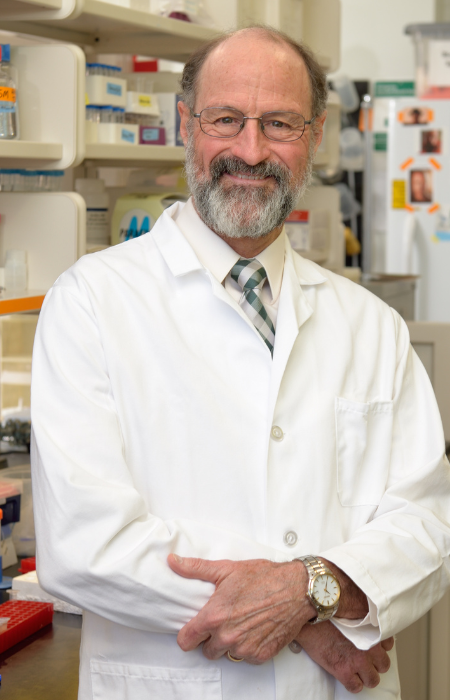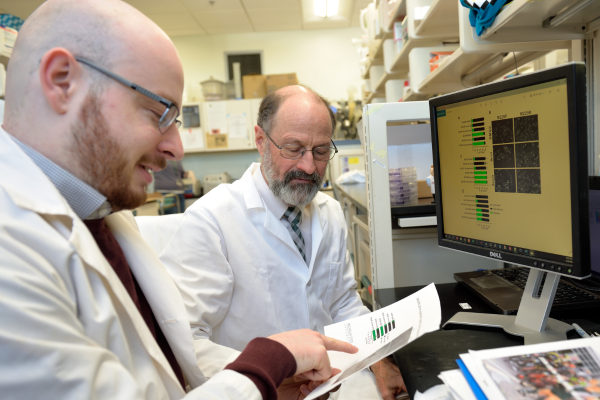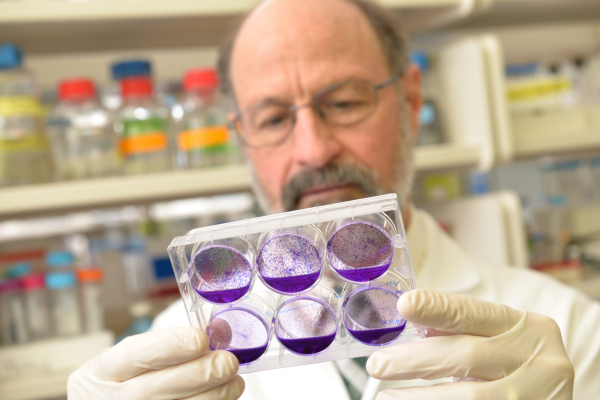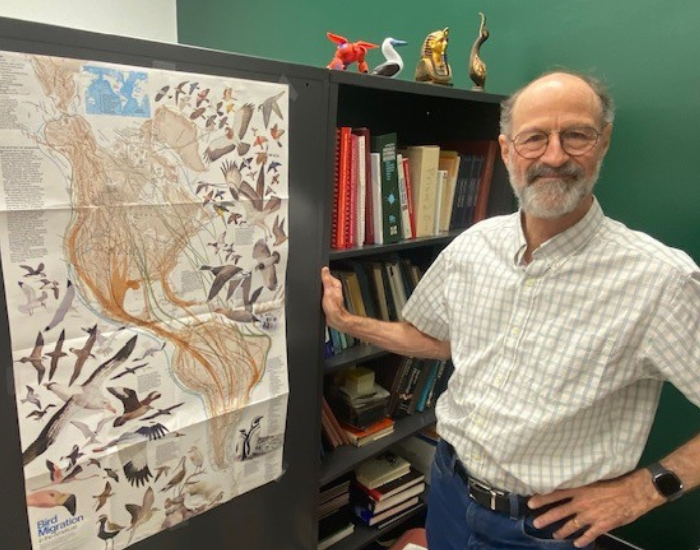A True Scientist: Richard Neubig Retires After Developing MSU’s Drug Discovery Program
August 22, 2024

For Richard Neubig, MD, PhD, all those years ago, it was the ubiquitous “a-ha” moment as he listened to a presentation from John Lazo, chairman of the Department of Pharmacology at the University of Pittsburgh, describing a burgeoning field called “Academic Drug Discovery.”
“It was the inspiration from John Lazo,” Neubig said of that presentation more than 20 years ago when he was a professor at the University of Michigan (U-M). “That got me interested. This was a transition for me from basic biochemical mechanisms to a translational path on how we can develop drugs that would be valuable and therapeutic.”
And it set Neubig on a path he would never leave.
“It was pretty cool,” he said.
Drug discovery is the process through which potential new therapies are identified using a combination of computational, experimental, translational, and clinical models.
Inspired, he received support from U-M to create a fledgling drug discovery program in the form of a robot, some 10,000 compounds with which to perform tests, and the aid of a graduate student, Chris Evelyn.
“It was early-stage drug discovery,” said Neubig, and it received a boost when his lab partnered with the Life Sciences Institute to set up a drug screening center called the Center for Chemical Genomics, which is still going strong at U-M.
But that was just the beginning for Neubig.
A New Challenge

In 2013, Michigan State University’s Pharmacology & Toxicology Department was seeking a new department chair and Neubig was seeking a new challenge. After a competitive national search, he was offered the position. While he was intrigued by the opportunity, he knew there was one requirement before he made the leap.
“I very explicitly said one of my key goals was to establish a drug discovery program at Michigan State by building the same type of resources, large groups of chemicals that can be screened using these robots,” he said. “The opportunity to come to Michigan State as chair and recruit faculty and build such a program was something I found very appealing.”
MSU agreed to his request and in the 11 years that followed, Neubig created a renowned program from the ground up.
Consider the accomplishments in that time:
- Create the Assay Development and Drug Repurposing Core (ADDRC), which performs high throughput screening and assists researchers with bridging the drug discovery gap that often exists between their basic research and preclinical drug development.
- Create and staff the Medicinal Chemistry Facility.
- Lead the Integrative Pharmacological Sciences Training Program through one renewal and one new application while expanding the program to include drug discovery and doubling the number of students that the program supports.
And consider the outcomes:
- These cores have supported some 60 faculty members from 13 departments and six colleges in project design and execution.
- Work done by the cores has resulted in least 15 patent applications and 35 funded extramural grants with income totaling more than $38 million.
- Four spinoff biopharma companies have been created.
“Rick transformed the Department of Pharmacology and Toxicology,” said Anne Dorrance, PhD, department chair. “We (the faculty) were all great at identifying physiologic targets for drugs but had to seek outside collaborations to make the next steps in drug discovery and development. Rick’s vision and his efforts to realize that vision have been game changing.”
A True Scientist
On July 1, Neubig retired, knowing there is much work yet to be done but content with the direction of the program.
 “I’m very happy,” he said. “I’m incredibly proud of the amazing faculty we have recruited, both in drug discovery and in PharmTox in general. My most positive feelings about what has happened here since I came has so much to do with the faculty. They’re fantastic.”
“I’m very happy,” he said. “I’m incredibly proud of the amazing faculty we have recruited, both in drug discovery and in PharmTox in general. My most positive feelings about what has happened here since I came has so much to do with the faculty. They’re fantastic.”
It began when he brought in specialists from outside of the academic arena such as Thomas Dexheimer, PhD, who had been with the National Center for Advancing Transitional Science (NCATS), to establish the ADDRC.
He also hired Edmund Ellsworth, PhD, who had 25 years of experience at Pfizer Pharmaceuticals. Ellsworth helped create, and directs, the medical chemical facility where he takes the compounds that have been identified in screening though the ADDRC or by other mechanisms and makes them more “drug-like” through medicinal chemistry.
“Rick is the driving force,” said Erika Lisabeth, PhD, director of the ADDRC. “He is passionate about science, and I was shocked how much I learned from him. He’s a true scientist.”
 It is a complicated, expensive, and often frustrating journey to find a physiologic target, identify chemical matter that interacts with that target and then to optimize that chemical to make it a useful drug. Once that process is complete the hope is always that pharmaceutical companies will invest and take that drug forward to the development process.
It is a complicated, expensive, and often frustrating journey to find a physiologic target, identify chemical matter that interacts with that target and then to optimize that chemical to make it a useful drug. Once that process is complete the hope is always that pharmaceutical companies will invest and take that drug forward to the development process.
But it has been a challenge worth pursuing.
“Rick’s involvement was to be the champion for Drug Discovery,” said Ellsworth, who is now interim director of the program as a national search begins for a replacement. “Rick has been supportive of us in getting the tools we need to bring all these pieces of together. In the midst of all this, Rick helped us bridge some of these challenges.”
And while there have been challenges, there have also been breakthroughs.
For example, two years ago, Robert Abramovitch, PhD, in the Department of Microbiology, Genetics and Immunology, and Karen Liby, PhD, in the PharmTox department were each awarded $300,000 Catalyst Awards from the Dr. Ralph and Marian Falk Medical Research Trust.
Liby, now at the University of Indiana but who remains an adjunct professor at MSU, is studying new cancer drugs and Abramovitch is studying tuberculosis and TB-like infections.
“Those grants transition beyond just academic studies and moves into a phase of development where we’re looking to actual clinical candidates, the name used to identify chemicals that have real potential as drugs,” said Neubig. “We’re looking at how we are going to get them to people.”
What’s Next
Though retired and with the new title of professor emeritus, Neubig will keep an eye on the MSU Drug Discovery program as it continues to grow and flourish.
He looks proudly at his trainees over the years, many of whom moved to industry or have become tenure-track professors at other schools and those who have made their names internationally in Norway, Malaysia, Taiwan, and South Africa.
 But these days, his interests focus on his love of nature, the outdoors and, of course, birds. Anyone who has joined him on his “Wednesday Warblers” sojourns to Baker Woodlot in the spring can identify with that.
But these days, his interests focus on his love of nature, the outdoors and, of course, birds. Anyone who has joined him on his “Wednesday Warblers” sojourns to Baker Woodlot in the spring can identify with that.
His love of birding goes back nearly 40 years, and he has seen more than 1,600 species of birds, a goal he reached in January on a two-week trip to Ecuador.
“It was amazing,” he said.
Neubig’s journey has been one of discovery, surprises, and some disappointment in unfinished work. But for now, he will stay connected to keep a hand in the work to which he has devoted so much time.
He will continue to share his knowledge and expertise with other organizations as a sought-after speaker and he will continue to watch the program he created from the ground floor grow and thrive.
But there will be empty places as well.
“I’ll miss working with the students,” he said. “I’ll miss talking about results and thinking about how to attack a problem. And I’ll miss just playing with data.”
Then he pauses.
“But mostly the students and helping them do science,” he said.
By Chuck Carlson
This story was originally published on the Department of Pharmacology & Toxicology website.

